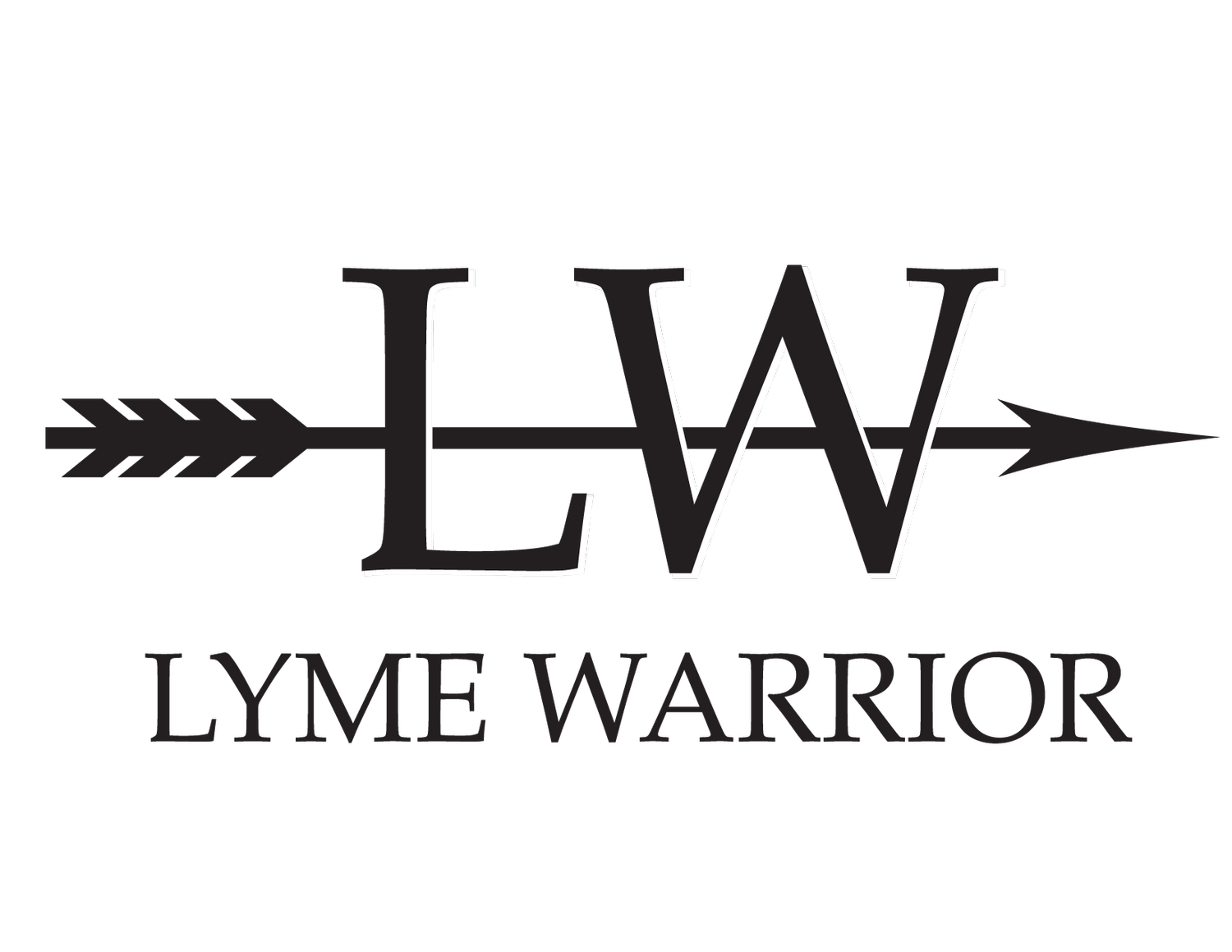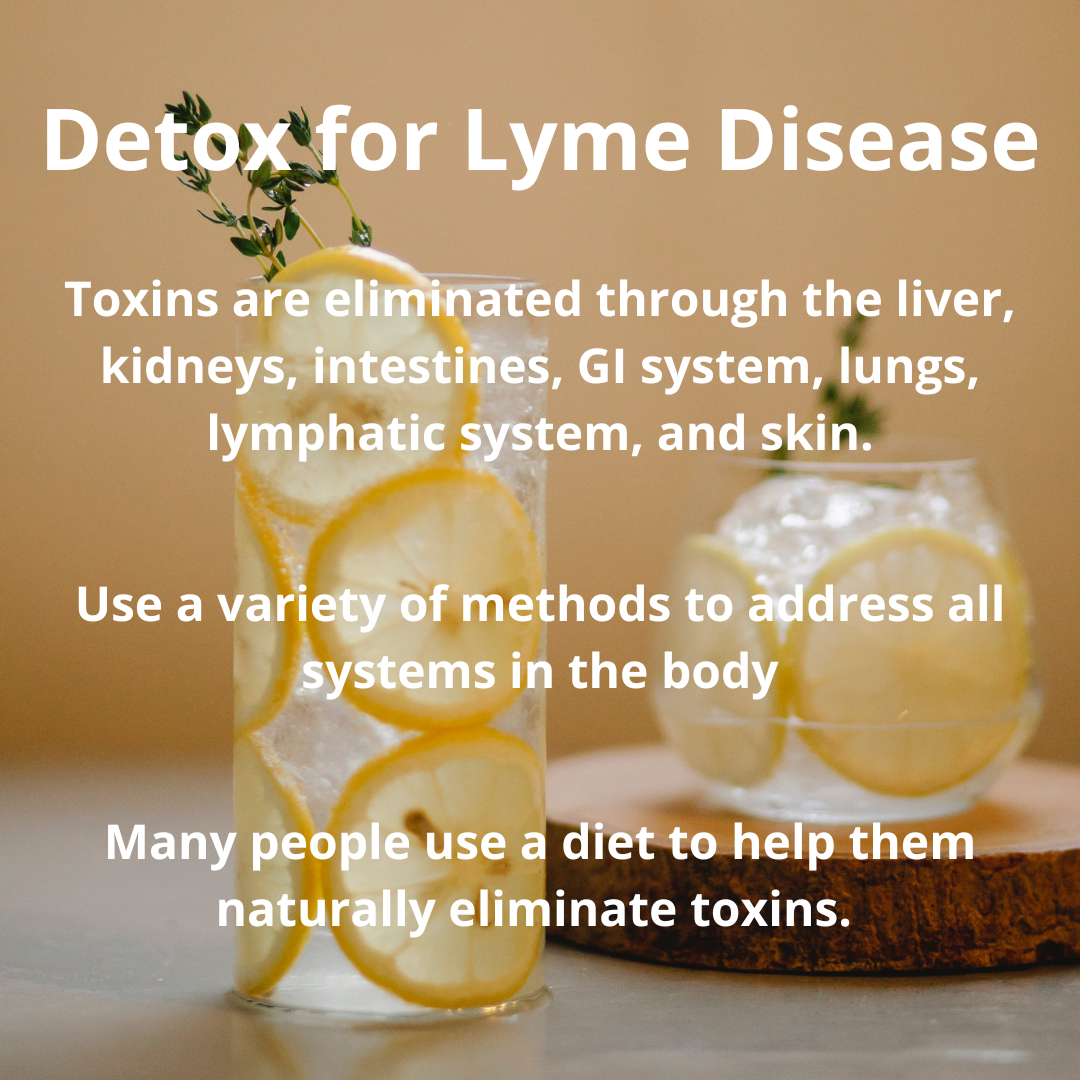Lyme Disease Detox
1. Why Detox for Lyme Disease?
Detoxing is a vital part of treating Lyme Disease as it provides relief from a herxheimer reaction (also known as die-off, release of endotoxins). Antibiotics or other treatment methods will kill the bacteria but the body must detox to remove the endotoxins that the spirochetes release once they are killed. We equate it to taking out the trash.
Detoxification is a means of cleansing the blood by removing impurities. Toxins are eliminated through the liver, kidneys, intestines, GI system, lungs, lymphatic system, and skin.
2. Using Detoxifying Herbs and Supplements
Detox methods can help you to remove toxins from Lyme disease through many methods. It is important to use a variety of methods to address all systems in the body that may become compromised through Lyme Disease and treatment. Detox methods remove toxins and withdraw them from your body so that your immune system can work more efficiently. It is important to note that binders specifically can’t differentiate between substances, so don’t use them within two hours of taking any herbs, supplements, or medications in order to make sure they are absorbed properly. Examples of binders are Charcoal, chorella, and clay listed below.
3. Lyme Disease Detox Methods
Some Detox methods recommended for Lyme include: (More details in this PDF from Lymexico.com)
Apple Cider Vinegar: When the body is ill, its pH becomes acidic. Apple Cider Vinegar will help to alkalize the body to return to homeostasis.
How To Use: Add 2 teaspoons of Apple Cider Vinegar to water and drink. - Purchase from Amazon here
Caution: Apple Cider Vinegar is an anti-fungal. If you are also dealing with a Candida infection, the use of apple cider vinegar may induce a herxheimer reaction rather than reduce.
Burbur & Pinella: A very common method for Lymies, Pinella offers brain and nerve support, Burbur is used for its powerful detoxing properties. Combined, these two herbs can eliminate toxins and offer detoxing properties for a full body cleanse and reset, from head to toe. Get it here and use code LYMEWARRIOR for a discount.
Chlorella: Chlorella binds to toxins and aides in prevention of reabsorption of the toxin in the digestive tract.
May be taken as a tablet, powder, or capsule. Do not take near medications or supplements.
Activated Charcoal: Binds to toxins.
May be taken as a tablet, powder, or capsule. Do not take with medications or supplements.
Infrared Saunas, Biomats, Infrared Mats: Body rids of toxins through sweat and eases pain through infrared heat. We highly recommend infrared mats. Find more about them here!
Caution: AVOID full body saunas if you have heat intolerance, i.e. dysautonomia.
Epsom Salt Bath: How to Use: Pour 2-4 cups of Epsom Salt into a warm bath (may also add Hydrogen Peroxide or banking soda) and soak for 20-40 minutes.
We highly recommend this Lyme Warrior run company who makes handcrafted salts.Caution: Avoid too hot of water as it may have the opposite effect and cause die off by killing spirochetes.
The magnesium in the Epsom salt relaxes the muscles and the sulfur in the Epsom salt produces bile which transports toxins from the liver to the colon.
Ionic Foot Baths - There are tons of variations in this product and people have different experiences, but Ionic Foot baths use charged ions to help open detox pathways in the body by soaking your feet and removing toxins through the soles of your feet.
Alka Seltzer Gold: Help to alkalize the body and remove toxins.
How to Use: Take 2 tables in water per box instructions as needed for herxing. Can be mixed with lemon water for alkalization.
Dry Skin Brushing: Stimulates lymphatic system
How To Use: Use a natural bristle brush to clear the pores. This is most commonly used before an Epsom Salt Bath.
Lemon Water: Lemons cleanse the body of toxins.
How To Use: Squeeze 2 whole lemons in 1 cup water; sip over 30 minutes.
Lymphatic Drainage Massage: Stimulates the lymph flow from the lymphatic system.
The lymphatic system is responsible for collecting toxins from cells; thus, allowing the body to remove them through sweat, bowel movements, and urine.
How To Use: It is important to locate a lymph massage certified masseuse. These massages are recommended 2-4 times a month.
Caution: Avoid deep tissue or deep muscle massages because these may expel toxins from the tissue and leave you feeling worse for 1-2 days.
Vitamin C: Helps the body produce glutathione that aids in detoxification.
Light Exercise: When the muscles contract, the lymphatic system is stimulated which transports toxins.
Humic and Vulvic Acid: Humic acid has been shown to chelate toxins and heavy metals, bind with bacteria and viruses, scavenge free radicals, and stimulate enzyme production. Fulvic acid is known to increase the absorption of minerals and other nutrients, improve cellular communication, and enhance glutathione levels.
Bentonite Clay: Very strong electrical negative charge, which helps bonds to the positive charge of toxins to help remove them from the skin and body.
Mix with water and apply to face and arm pits
Detoxifying bath: Add ¼ cup of clay and lavender essential oil to bath water
Things To Remember:
Do NOT put toxins in. Diet- i.e. organic foods, no alcohol, avoid sugar, etc.
Take a probiotic - Detoxifies digestive tract and promotes healthy gut flora.
Drink adequate water
Intake fiber. Binds to toxins and promotes regular bowel movements.
Deep Breathing. Releases gases from the lungs
Using Diet as a Detox for Lyme Disease
Many people use a diet to help them naturally eliminate toxins. This is not a total solution but can greatly help the body’s ability to remove toxins naturally. Most practitioners encourage Lyme Disease patients to use a proper diet and detox methods to support the body during Lyme Disease treatment.
Learn more about the options for Lyme Disease Diets here.
The Content is not intended to be a substitute for professional medical advice, diagnosis, or treatment. Always seek the advice of your physician or other qualified health provider with any questions you may have regarding a medical condition.
Lyme Disease Detox Frequently Asked Questions
Why is detox important for Lyme disease?
Detoxification is an important aspect of Lyme disease treatment because it helps to eliminate toxins and other harmful substances from the body. When a person is infected with Lyme disease, the bacteria can release toxins that can build up in the body and cause inflammation, which can lead to a wide range of symptoms.
One of the most common symptoms of Lyme disease is fatigue, which can be caused by the body's efforts to fight off the infection and eliminate the toxins. By supporting the body's natural detoxification processes, patients can help reduce inflammation and alleviate symptoms such as fatigue, brain fog, and joint pain.
Detoxification can also help support the immune system, which can be weakened by Lyme disease. When the body is overloaded with toxins, the immune system may become less effective at fighting off infections and other diseases. By reducing the toxin load in the body, patients can help support the immune system and improve overall health.
Is there a specific Lyme detox diet?
There is no specific "Lyme detox diet" that is universally recommended for Lyme disease patients, but there are certain dietary guidelines that may help support the body's natural detoxification processes and promote overall health.
One of the key principles of a Lyme detox diet is to focus on whole, nutrient-dense foods that are free from processed ingredients and additives. This means avoiding processed foods, refined sugars, and artificial sweeteners, which can contribute to inflammation and disrupt the body's natural detoxification processes. Instead, patients are encouraged to eat a variety of fresh fruits and vegetables, lean proteins, and healthy fats. These foods are rich in vitamins, minerals, and antioxidants that can help support the immune system and promote detoxification.
Some Lyme disease patients may also choose to follow a specific dietary approach, such as the paleo diet, the ketogenic diet, or the autoimmune protocol (AIP) diet. These diets focus on nutrient-dense foods and eliminate common food allergens and inflammatory ingredients, which may help reduce inflammation and support overall health. Check out Diets for Lyme Disease & resources here.
Can detoxing cure Lyme disease?
Detoxification cannot cure Lyme disease on its own, but it can be an important part of a comprehensive treatment plan that includes antibiotics or other medications, dietary changes, and other therapies.
Lyme disease is caused by a bacterial infection that requires medical treatment with antibiotics or other antimicrobial agents. Detoxification can help support the body's natural healing processes and alleviate symptoms such as fatigue and joint pain, but it cannot cure the underlying infection.
What are some common detox methods used by individuals with Lyme disease?
Common detox methods used by individuals with Lyme disease include: (See our list above as well) (Always consult a physician before trying any of these detox methods)
Hydration: Drinking plenty of water to flush out toxins and support kidney function.
Nutritional support: Consuming a nutrient-dense diet rich in antioxidants and essential nutrients to support the body's detoxification processes.
Sweating: Engaging in activities that induce sweating, such as exercise, saunas, or salt baths, to facilitate toxin elimination through the skin.
Herbal supplements: Using specific herbs and supplements known for their detoxifying properties, such as milk thistle, dandelion root, and glutathione.
Colon cleansing: Some individuals may opt for colon cleansing techniques like enemas or colon hydrotherapy to support bowel elimination and remove toxins.
Can detoxification methods help with the symptoms of Lyme disease?
Detoxification methods can help alleviate symptoms associated with Lyme disease by reducing the overall toxic load on the body. While they may not directly treat the underlying infection, supporting detoxification pathways can contribute to improved overall well-being and symptom management.
Are there any risks or precautions to consider when using detox methods for Lyme disease?
It's important to approach detox methods for Lyme disease with caution and under the guidance of a healthcare professional experienced in Lyme disease treatment. Detoxification processes can sometimes release a large amount of toxins into the bloodstream, causing temporary discomfort or a "detox reaction." Additionally, certain detox methods may not be suitable for everyone, such as individuals with pre-existing medical conditions or those taking specific medications.
How long should detoxification methods be used for Lyme disease?
The duration of detoxification methods can vary depending on individual needs and treatment plans. Some individuals may incorporate ongoing detox practices as part of their long-term wellness routine, while others may focus on detoxification during specific phases of treatment. It is best to work with a healthcare professional to determine an appropriate timeframe for detoxification based on your specific situation.
Can detoxification methods be used alongside conventional Lyme disease treatment?
Yes, detoxification methods can be used alongside conventional Lyme disease treatment. In fact, they are often integrated into comprehensive treatment plans to support the body's healing process and enhance the effectiveness of conventional therapies. However, it's important to coordinate detoxification methods with your healthcare provider to ensure they are appropriate for your specific case and treatment plan.


